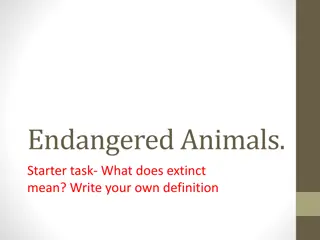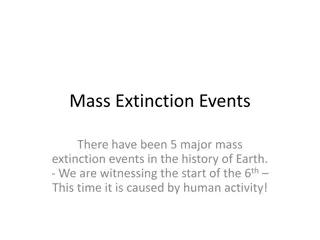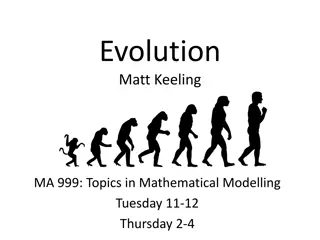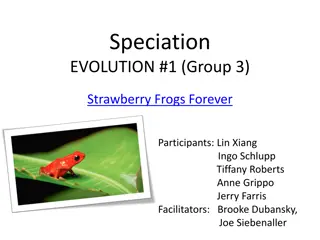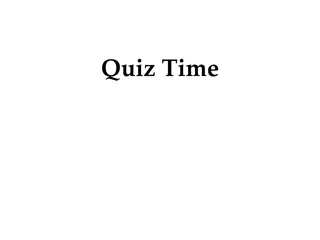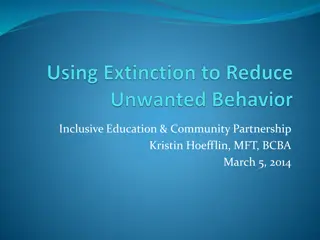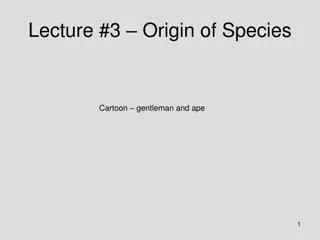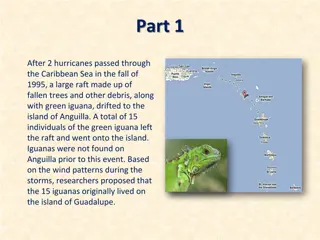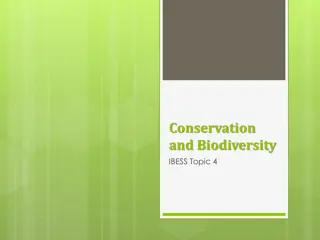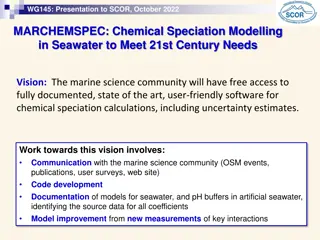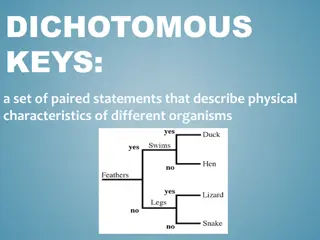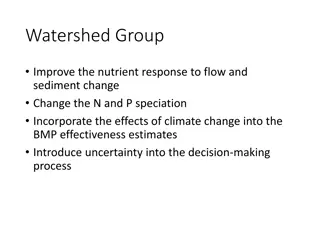Understanding Speciation and Extinction in Evolutionary Biology
Explore the modes of speciation and causes of extinction in the evolutionary process. Learn how species evolve to become distinct through geographic isolation and reduced gene flow. Understand the implications of extinction and its impact on biodiversity. Images and descriptions provided offer insights into the intricate mechanisms of speciation and the sobering reality of extinction events.
Download Presentation

Please find below an Image/Link to download the presentation.
The content on the website is provided AS IS for your information and personal use only. It may not be sold, licensed, or shared on other websites without obtaining consent from the author. Download presentation by click this link. If you encounter any issues during the download, it is possible that the publisher has removed the file from their server.
E N D
Presentation Transcript
MODES OF SPECIATION, CAUSES AND CONSEQUENCES OF EXTINCTION
Species & Speciation Species A group of living organisms consisting of similar individuals capable of exchanging genes or interbreeding. Speciation It is the evolutionary process by which populations evolve to become distinct species. Charles Darwin was the first to describe the role of natural selection in speciation in his 1859 book On the Origin of Species.
Causes of speciation 1. Geographic isolation It is the separation of two populations of the same species by a physical barrier. e.g. Organisms migrate mountain formation Island formation Large scale human activities 2. Reduction of gene flow Individuals in the far west would have zero chance of mating with individuals in the far eastern end of the range. So we have reduced gene flow.
Extinction EXTINCTION Extinction is the termination of a kind of organism or of a group of kinds (taxon), usually a species. The moment of extinction is generally considered to be the death of the last individual of the species, although the capacity to breed and recover may have been lost before this point.
The passenger pigeon, one of hundreds of species of extinct birds, was hunted to extinction over the course of a few decade.
CAUSES Humans can cause extinction of a species through: Overharvesting. pollution. habitat destruction. introduction of invasive species (as new predators and food competitors). overhunting, and other influences. Explosive, unsustainable human population growth is an essential cause of the extinction crisis. 784 extinctions have been recorded since the year 1500, the arbitrary date selected to define "recent" extinctions, up to the year 2004; with many more likely to have gone unnoticed.
1. Genetics and demographic phenomena If adaptation increasing population fitness is slower than environmental degradation plus the accumulation of slightly deleterious mutations then population will go extinct. Limited geographic range but it becomes increasingly irrelevant as mass extinction arises. Extinction rate can be affected not just by 1. population size but 2. balancing selection, cryptic genetic variation, phenotypic plasticity, and robustness. 3. A diverse or deep gene pool. 4. Population bottlenecks.
2. Genetic Pollution Extinction can threaten species evolved to specific ecologies through the process of genetic pollution i.e, uncontrolled hybridization, introgression genetic swamping which leads to homogenization or out-competition from the introduced (or hybrid) species. Endemic populations can face such extinctions when new populations are imported or selectively bred by people, or when habitat modification brings previously isolated species into contact. The endangered wild water buffalo is most threatened with extinction by genetic pollution from the abundant domestic water buffalo). Such extinctions are not always apparent morphological observations. from
Scorched land resulting from slash-and- burn agriculture.
3.Habitat Degradation. The main cause of habitat degradation worldwide is agriculture, with urban sprawl, logging, mining and some fishing practices close behind. It may alter the fitness landscape to such an extent that the species is no longer able to survive and becomes extinct. This may occur by direct effects or indirectly. Habitat degradation through toxicity can kill off a species very rapidly. It can also occur over longer periods at lower toxicity levels by affecting life span, reproductive capacity, or competitiveness.
physical habitats. The widespread destruction of tropical rainforests and replacement with open pastureland is widely cited as an example of this; elimination of the dense forest eliminated the infrastructure needed by many species to survive. For example, a fern that depends on dense shade for protection from direct sunlight destruction of ocean floors by bottom trawling. destruction of niche 1. Diminished resources or introduction of new competitor species also often habitat degradation. 2. Global warming accompany Vital resources including water and food can also be limited during habitat degradation, leading to extinction. The golden toad was last seen on May 15, 1989.
Decline in amphibian populations is ongoing worldwide.
4.Predation,Competition And Diseases. Extinction of a necessary host, prey or pollinator, inter- species competition. Inability to deal with evolving diseases and changing Environmental conditions changes) which can act to introduce novel predators, or to remove prey. Sometimes intentionally (e.g. livestock released by sailors on islands as a future source of food) and sometimes accidentally (e.g. rats escaping from boats). (particularly sudden In most cases, the introductions are unsuccessful, but when an invasive alien species does become established, the consequences can be catastrophic. Invasive alien species can affect native species directly by eating them, competing with them, and introducing pathogens or parasites that sicken or kill them; or indirectly by destroying or degrading their habitat
5. Co-extinction Co-extinction refers to the loss of a species due to the extinction of another; for example, the extinction of parasitic insects following the loss of their hosts. Co-extinction can also occur when a species loses its pollinator, or to predators in a food chain who lose their prey. Co-extinction is especially common when a keystone species goes extinct. Models suggest that co-extinction is the most common form of biodiversity loss. . Haast's eagle and the moa: the Haast's eagle was a predator that became extinct because became extinct. The moa were several species of flightless birds that were a food source for the Haast's eagle. its food source
6. Climate Change. Extinction as a result of climate change has been confirmed by fossil studies. The ecologically rich areas that would potentially suffer the heaviest losses include the Cape Floristic Region, and the Caribbean Basin. These areas might see a doubling of present carbon dioxide levels and rising temperatures that could eliminate 56,000 plant and 3,700 animal species. Climate change has also been found to be a factor in habitat loss and desertification. Extinction of amphibians during the Carboniferous Rainforest Collapse, 305 million years ago. A 2003 review across 14 biodiversity research centers predicted that, because of climate change, 15 37% of land species would be "committed to extinction" by 2050.
Effects Of Extinction The results of a study released in the summer of 2011 have shown that the decline in the numbers of large predators like sharks, lions and wolves is disrupting ecosystem in all kinds of unusual ways. Earth's The study states that the mass extinction differs from previous ones because it is entirely driven by human activity through changes in land use, climate, pollution, hunting, and fishing. The effects of the loss of these large predators can be seen in the oceans and on land.
In the oceans, industrial whaling led a change in the diets of killer whales, who eat more sea lions, seals, and otters and have lowered the population counts of those species. dramatically The study concludes that the loss of big predators has likely driven many of the pandemics, collapses and ecosystem shifts the Earth has seen in recent centuries. population




